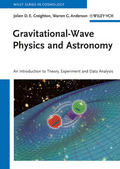Gravitational-Wave Physics and Astronomy
An Introduction to Theory, Experiment and Data Analysis
Wiley Series in Cosmology

1. Auflage September 2011
XXII, 359 Seiten, Hardcover
41 Abbildungen
9 Tabellen
Monographie
Kurzbeschreibung
Written by outstanding expert researchers directly involved with the LIGO, this most up-to-date, one-stop reference combines theory and observational techniques, while featuring introductory sections to bring all readers up to the same level.
Jetzt kaufen
Preis: 182,00 €
Preis inkl. MwSt, zzgl. Versand
Euro-Preise für Wiley-VCH- und Ernst & Sohn-Titel sind nur für Deutschland gültig. In EU-Ländern gilt die lokale Mehrwertsteuer. Portokosten werden berechnet.
This most up-to-date, one-stop reference combines coverage of both theory and observational techniques, with introductory sections to bring all readers up to the same level. Written by outstanding researchers directly involved with the scientific program of the Laser Interferometer Gravitational-Wave Observatory (LIGO), the book begins with a brief review of general relativity before going on to describe the physics of gravitational waves and the astrophysical sources of gravitational radiation. Further sections cover gravitational wave detectors, data analysis, and the outlook of gravitational wave astronomy and astrophysics.
Prologue: Tides in Newton's gravity/Relativity
1. A brief review of General Relativity
2. Gravitational waves
3. Beyond the Newtonian limit
4. Sources of gravitational radiation
5. Gravitational wave detectors
6. Gravitational wave data analysis
Epilogue: Gravitational wave astronomy and astrophysics
A. Gravitational wave detector data
B. Post-Newtonian Binary Inspiral Waveform
Warren G. Anderson is a scientist at the University of Wisconsin?Milwaukee and a member of the LIGO Scientific Collaboration, which he joined in 1998. He received his doctorate at the University of Alberta under Werner Israel, where he worked on Black Hole physics, and has also held a tenure track position at The University of Texas at Brownsville. He also received Master's degrees in Medical Physics (University of Alberta) and Applied Mathematics (University of Waterloo).


